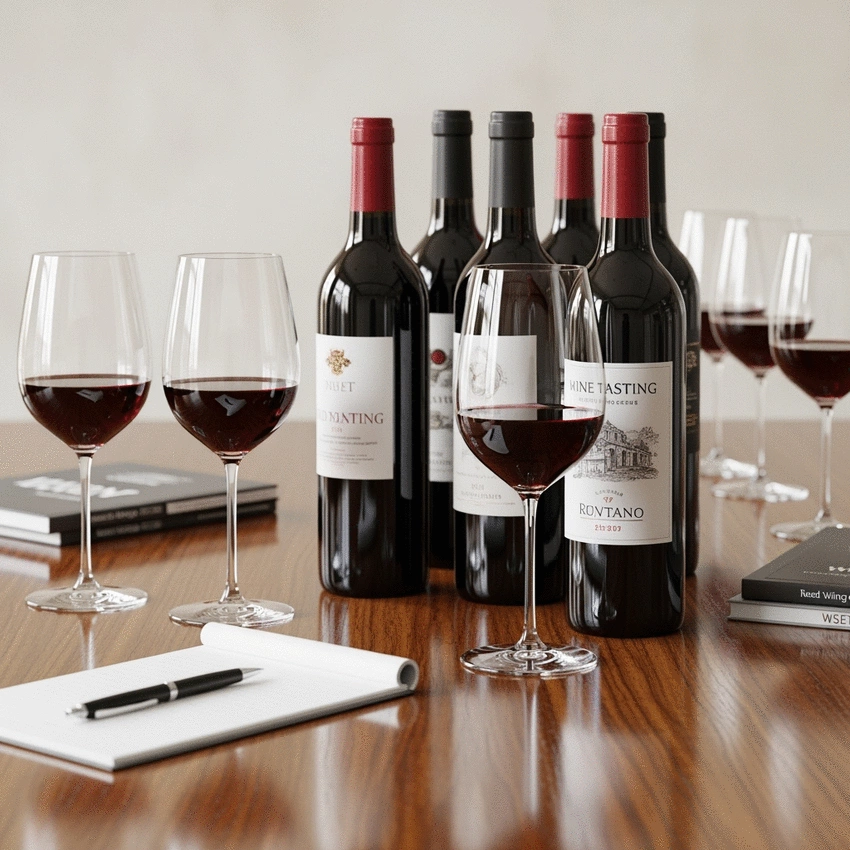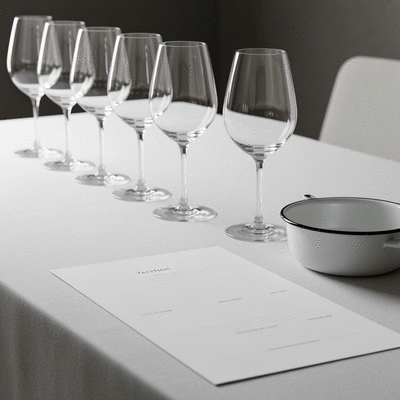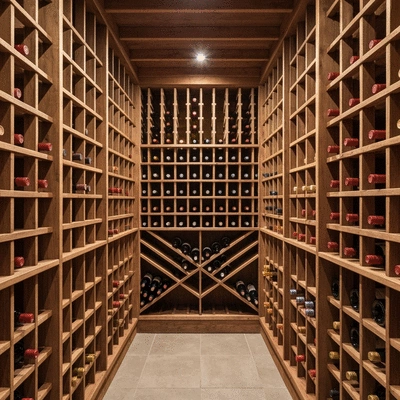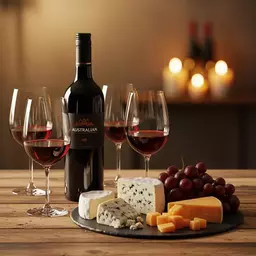Choosing the Right Australian Red Wine
By Clara Hastings / Nov 02
Have you ever found yourself puzzled by the complex world of red wine tasting? If so, you're not alone! The WSET Systematic Approach to Tasting provides a structured framework that can enhance both your tasting skills and your enjoyment of wine.
The WSET Systematic Approach to Tasting (SAT) provides a structured method for evaluating red wines. This visual outlines the key stages and common mistakes to avoid, enhancing your tasting experience.
(Follow these systematically for better evaluation)
(Avoid these for accurate assessments)
(Enhance your experience and knowledge)
(Preserves quality and flavor)
As a passionate wine enthusiast, I can’t emphasize enough the value of mastering the WSET Systematic Approach to Tasting. This structured method not only enhances your tasting skills but also deepens your appreciation for red wines. Whether you're a newbie or a seasoned sommelier, the WSET framework offers a clear pathway to understanding every glass of wine you enjoy.
The WSET (Wine & Spirit Education Trust) provides a well-defined format for tasting that covers all the essential aspects of wine evaluation. By adopting this systematic approach, you can accurately assess the quality of red wines, from the appearance to the palate, making your tasting experience more rewarding. You can learn more about Australian red wine basics to further enhance your foundational knowledge.
The WSET Systematic Approach to Tasting (SAT) is a method designed to help you break down and analyze wines in a structured manner. This approach encompasses four main components: appearance, nose, palate, and conclusion. Each step encourages you to observe and describe specific characteristics, making wine tasting less daunting and more enjoyable.
By following these steps, you can develop a more nuanced understanding of red wines, ultimately enhancing your enjoyment. It's all about becoming more attuned to what you're tasting and learning which attributes resonate with your preferences!
Having a structured tasting routine is crucial for anyone looking to deepen their wine knowledge. It serves as a foundation upon which you can build your tasting skills. With a consistent approach, you can identify trends in your preferences and develop your palate over time.
As you practice this routine, you'll find that consistency leads to greater confidence and enjoyment in your wine journey. Trust me, it transforms the way you perceive and appreciate every bottle you open! For a deeper dive into expert techniques, consider how to taste red wine like an expert.
Pursuing a WSET certification can significantly elevate your understanding of red wines. This globally recognized qualification not only teaches you the SAT but also provides in-depth knowledge about wine regions, grape varieties, and production methods. It’s like a passport into the fascinating world of wine!
Completing a WSET course can open doors to numerous opportunities, whether you're considering a career in wine or simply want to enhance your personal knowledge. You’ll join a community of wine lovers and professionals who share a passion for exploring the complexities of this delightful beverage.
Did you know? Taking a moment to observe the 'legs' of the wine can provide insights into its body and alcohol content. After swirling the wine in your glass, look for the streaks that form on the inside; thicker legs often indicate a fuller-bodied wine, while thinner legs suggest a lighter style. This simple observation can enhance your overall tasting experience!
Tasting red wines can be a delightful experience, but it’s easy to make some common mistakes that can cloud your judgment. One frequent error is rushing through the tasting process without taking the time to fully engage your senses. Wine tasting is about savoring each sip, not just identifying whether you like it or not! Another mistake is neglecting to cleanse your palate between different wines, which can lead to misleading impressions of flavor.
Additionally, many novice tasters overlook the importance of temperature. Serving red wines too warm or too cold can significantly alter the tasting experience. Make sure you’re aware of the ideal serving temperatures for different varietals, as this can enhance the aromas and flavors that you will experience.
These mistakes can hinder your tasting experience and the accuracy of your assessments. Taking a moment to reflect on your tasting approach can make a significant difference!
To enhance your red wine tasting experience, it’s essential to adopt some effective solutions and best practices. First, create a structured routine that allows you to evaluate each wine thoroughly. This can include taking detailed notes and setting aside time to contemplate each sip. You’ll find that this practice heightens your appreciation for the nuances in flavor and aroma.
Another practical solution is to invest in proper wine storage. A wine fridge or a cool, dark place will keep your bottles at their best. Remember, maintaining quality is key to enjoying the rich stories that each bottle has to tell!
Adopting these best practices not only enhances your tasting experience but also shows respect for the craftsmanship behind each bottle. Remember, treating your wine well means you’ll enjoy it at its very best!
One of the most exciting aspects of the wine world is that there’s always more to learn! I encourage you to refine your tasting skills regularly, as practice makes perfect. Whether you're a beginner or an experienced taster, each session presents an opportunity to deepen your understanding of red wines.
As I’ve explored various Australian vineyards, I've found that consistent practice not only sharpens your palate but also cultivates your confidence in wine selection and pairing. So, pour yourself a glass, take your time, and enjoy the journey! If you're looking to expand your collection, you can easily buy Australian red wines online.
Engaging with a community of wine lovers not only enhances your experience but allows you to share insights and grow together!
If you’re eager to expand your wine knowledge, there are fantastic resources available! Online courses, local workshops, and even books can provide valuable insights into wine tasting techniques and varietal characteristics. I personally recommend looking into the WSET courses, which offer a structured approach to tasting and wine knowledge.
Don’t forget to check out local wine events and tastings; they can be a great way to learn while connecting with other wine lovers. There’s a whole world of knowledge waiting out there—soak it up!
Engaging with the wine community enhances your learning experience, and who knows—you might even discover your new favorite wine! So, let’s raise a glass to continuous learning and the joys of red wine tasting!
The WSET SAT is a structured method for evaluating wines, focusing on four key components: appearance, nose, palate, and conclusion. It helps tasters systematically analyze and describe a wine's characteristics to form an overall judgment.
A structured routine improves focus on each wine component, enhances the ability to communicate tasting notes effectively, and aids in retaining information and experiences, leading to greater confidence and enjoyment.
WSET certification provides in-depth knowledge about wine regions, grape varieties, and production methods, in addition to teaching the SAT. It's a globally recognized qualification that deepens understanding and opens doors to opportunities within the wine community.
Common mistakes include rushing the tasting process, ignoring optimal serving temperatures, neglecting to cleanse the palate between wines, and improper wine storage, all of which can negatively impact the accuracy and enjoyment of your assessment.
Best practices for wine storage involve maintaining consistent temperature control (12-18°C), optimal humidity levels (50-70%) to keep corks moist, storing bottles in darkness away from light and heat, and positioning bottles horizontally to ensure the cork stays wet and sealed.
Here is a quick recap of the important points discussed in the article:



 Choosing the Right Australian Red Wine
Choosing the perfect Australian red wine can significantly enhance your dining experience. Are you r
Choosing the Right Australian Red Wine
Choosing the perfect Australian red wine can significantly enhance your dining experience. Are you r
 Australia's Red Wine Regions Explored
The journey through Australia's red wine landscape is as rich and varied as the wines themselves. Ha
Australia's Red Wine Regions Explored
The journey through Australia's red wine landscape is as rich and varied as the wines themselves. Ha
 Sustainable Red Wine and the Earth
What if your wine choices could help save the planet? Sustainable red wine production not only ensur
Sustainable Red Wine and the Earth
What if your wine choices could help save the planet? Sustainable red wine production not only ensur